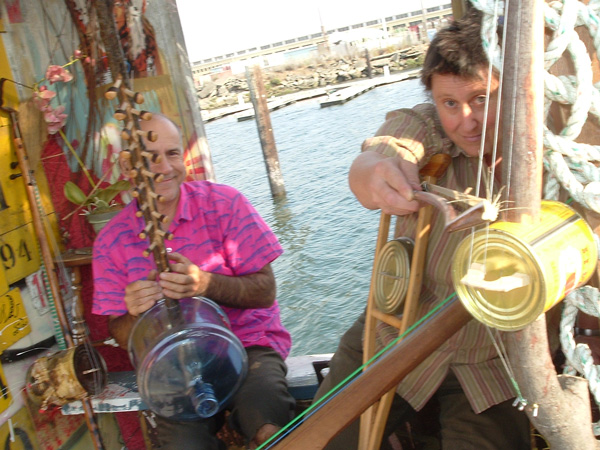

The Wreck of the Old #10 is an eclectic group of Bay Area musicians formed to play the instruments of the Tin Can Banjo Project. We play tunes from the vernacular traditions of Appalachia, Eastern Europe and the American South on instruments made from found or repurposed objects.
By making our instrument from tin cans and other junk, minimally processed natural materials, and ordinary articles of commerce, and we hope to show the way to a renewed and updated tradition of folk instrument making, much as the music we play has continued to adapt and evolve over centuries, and to undermine the preciousness and fetishizing of standard european instruments.
Our instruments are mostly built on the drum and stick principle. Instruments of this sort are made and played on every continent and range in sophistication of construction from the Japanese Shamisen to the North African Guimbre. The music we draw from is primarily instrumental, with melody and rhythm foremost. Its harmonic content is rudimentary at best. Most of the instruments have no fixed stops (frets) permitting the subtlety of intonation common to music that is principally melodic. It is also "instrumental" in the sense of being generally performed for a purpose--dancing, parading or working.
Much of the music we study was played on improvised or marginal instruments made from cast off materials and whatever was available, often in situations of extreme poverty. This music was transmitted aurally (and orally) from generation to generation, isolated by geographic and socio-economic conditions, minimally touched by proper musical education, and yet inclusive of whatever cultural contact and "exotic" influences that came along. It is only fitting that we merge our modern day instruments made from the riches-of-the-trash-heap with this music.
We strive for acoustic immediacy and avoid instruments that require an electronic pick-up to be heard. While realizing that modern stringed instruments are what they are because the trajectory of instrument making has been towards volume, (the violin, for example, is louder than the viol or the rebab), we feel any instrument worthy of the name must be at least audible in a room with good acoustics and a reasonably attentive audience. We do accommodate less than perfect performance environments with simple one or two microphone sound re-inforcement.
We performed in September 2008 at the Luggage Store Gallery in San Francisco, as part of the Thingamajig Festival. We were joined at this performance by wind instrument tinkerer Fran Holland, who honked along with us on some of his creations.
Karen Celia Heil, musical director
A Fiddler, guitarist, stand-up bassist and vocalist, Karen mainly works within the old American music genres of turn-of-the-century Appalachia and Southwest Louisiana, known as Old-Time and Cajun. She performs and teaches in and around San Francisco, at festivals and music camps, with her frequent collaborations taking many musical and artistic forms. Other interests and artistic endeavors have included world travel as a merchant sea-person, a ceramicist, and studies in geology and culinary arts. Karen is currently teaching Old Timey Fiddle at Zambaleta in San Francisco's Mission district.
Keenan Webster Keenan was born in Nashville, Tennessee. His interest in music deepened as a teenager in Los Angeles, California where he began his music studies with Master Teachers from Cuba and Africa. Surrounded by a highly spiritual family, he has spent his life concentrating on the study of religion, history, and music. His musical influences include John Coltrane, Miles Davis, John Lee Hooker, Taj Mahal, El Hadj, Kouyate, Ali Farka Toure, Milt Jackson, and Keletigue Diabate. He extends his experimentation and improvisation to the traditional African instruments balafon and kora.
Erik Pearson Erik's gritty and orchestral guitar style and composer's touch has shaped the sounds of recordings by bands including Mushroom, University of Errors, Sonya Hunter, Alice Bierhorst, , Irene Sazer, Pat Thomas, Nearly Beloved, and Billy Talbot. He plays banjo with old time mavericks The Crooked Jades and accompanies internationally renowned storyteller Diane Ferlatte on banjo and guitar. Erik studied music composition at Oberlin Conservatory. His chamber music compositions have been performed around the US, and he has been praised in local press for scores and soundscapes written for San Francisco and New York choreographers. Erik is currently a member of the teaching faculty at the Community Music Center in San Francisco.
Fran Holland
Builds and plays horns, organs, and other instruments out of modern refuse.
He has been teaching other folk how to do likewise for twenty years ( at Skillshare events, the Tinkers Workshop, the Exploratorium, the Lawrence Hall of Science, SFMOMA, and the Oakland Museum of CA.), as well as building interactive exhibits and installations for museums, community centers, county fairs, and schools. He plays bass clarinet in the jazz sextet Big Box.
You are visitor #